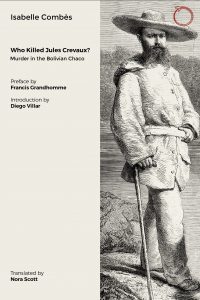Murder in the Bolivian Chaco
By Isabelle Combès
With a Preface by Francis Grandhomme and an Introduction by Diego Villar
In 1882, the celebrated French explorer Jules Crevaux and his crew were killed by Indigenous people in the Bolivian Chaco, a fiercely contested region on the border between Bolivia, Argentina, and Paraguay. The event sparked an international uproar. The scene of the crime was embroiled in clashes among various Indigenous peoples, rubber tappers, and missionaries. Official investigators sent from France and competing newspapers ended up mired in a morass of equivocal, ambiguous, false, and contradictory information.
To make sense of this event, Isabelle Combès is the first researcher to consult the local archives and to include the perspective of Indigenous peoples. In search of who killed Crevaux and why, Combès unearths the power struggles and social imaginaries behind the incident and its aftermath. Readers will find not only an engrossing story in these pages but also an exemplar of historical inquiry that questions the very nature of truth-telling.
“Reading Who Killed Jules Crevaux?, we realize that, despite the hundreds of pages written about him, we still know very little about the murder of the expedition members. The few studies on the subject are based on often secondary, sometimes deliberately misleading, and always fragmentary French sources. Isabelle Combès, who lives in Bolivia near the site of the massacre, has had the happy idea to conduct her investigation in situ, where she seeks out firsthand sources, many of which are unpublished. Her approach is revolutionary.”
— Francis Grandhomme, Preface
“The tragedy provoked as much shock in Bolivia as it did in Argentina and France, home of the expeditionary party; but as the detective/ethnohistorian Isabelle Combès remarks, the actual murder is in fact the only reliable information we have. The general commotion prompted by the Crevaux myth is a vanishing trail of rumors, legends, snippets of information, forgetfulness, misunderstandings, half-truths, lies, opacities, exaggerations, and even blatant falsifications. In a plot in which nothing can be assumed to be true, all versions are to a certain degree plausible, the actors are both victims and detectives, and everyone—Indigenous peoples, explorers, colonists, military men, missionaries, guides, interpreters, cooks, witnesses—accuses everyone else: just as in detective novels, the suspense is maintained by suggesting at every step that the culprit is someone else.”
— Diego Villar, Introduction
Isabelle Combès is an associate researcher with the Institut Français d’Études Andines and coordinator of the Centro de Investigaciones Históricas y Antropológicas of the History Museum of La Universidad Autónoma Gabriel René Moreno, Santa Cruz de la Sierra, Bolivia.
Francis Grandhomme is a recognized authority on exploration of the Chaco. He is an associate member of the Centre de Recherche Universitaire Lorrain d’Histoire at Nancy and teaches at the Fustel de Coulanges lycée in Strasbourg. His research focuses on exploration, but also on borders and border conflicts in the nineteenth-twenty-first centuries.
Diego Villar is a Marie-Skłodowska Curie fellow at the Università Ca’ Foscari (Venice). His work centers on the anthropology and ethnohistory of the Argentinian Chaco and, more broadly, Bolivian Amazonia.
Nora Scott has translated numerous books in anthropology and related social sciences. In 2013, she was awarded the prestigious French-American Foundation Translation Prize.
Initially published as Qui a tué Jules Crevaux? Le dossier criminel bolivien
© 2022 Éditions La Valette, French edition
© 2023 Hau Books , English translation
6″ x 9″, 166 pp.
$25
Contents
Selected Bibliography
The PDF of this book, attached above, is made available by Hau Books. Additional rights clearance may be necessary for third-party content within.
